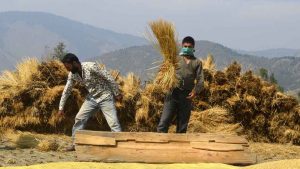 Chandigarh: Farmers in the northern states of Punjab and Haryana that are considered the granaries of India are forced to burn paddy residue in the open owing to lack of technology for its management and no cash incentive to dispose it scientifically, believe agricultural experts.
Chandigarh: Farmers in the northern states of Punjab and Haryana that are considered the granaries of India are forced to burn paddy residue in the open owing to lack of technology for its management and no cash incentive to dispose it scientifically, believe agricultural experts.
But citing helplessness in terms of burning being the only way, the governments are blaming one another for failure to check the stubble burning.
The farmers were caught in a vicious time-cycle as they have to harvest rice from mid-October to mid-November each year and cultivate wheat in a space of 10-15 days.
“Rice straw is not used for fodder, so we have to dispose after every harvest. Since the government is not coming up with any cash incentives, most of the farmers prefer to burn it despite the ban,” Ajaib Singh, a 65-year-old farmer who owns 10 hectares on the outskirts of Punjab`s Khanna town, the biggest grain market in Asia.
Chief Minister Amarinder Singh has been seeking cost compensation of Rs 100 per quintal of paddy from the Centre to motivate the farmers against burning of residue in the fields.
A sum of Rs 100 per quintal of paddy should be given to farmers so that they can arrange to manage the stubble without resorting to its open burning by using the compensation money to meet the paddy straw management cost, the Chief Minister said in his letter to the Prime Minister on September 25.
Agriculture officials told every year after post-paddy harvest Punjab faces the challenge of managing nearly 20 million tonne of paddy straw.
Going by estimates, about 85-90 per cent of this paddy straw is burnt in the fields.
On its part, the state is doing all it could to check the problem of stubble burning by providing around 28,000 paddy straw management machines to the farmers last year on subsidy ranging from 50 to 80 per cent.
Another 26,000 machines would be supplied to them this year, in addition vigorous campaigns at the grassroots to sensitize farmers against stubble burning, and its ill effects on environment and human health.
The situation is a far cry as majority of farmers struggle for survival in Punjab and Haryana.
An additional cost of using the machines that is between Rs 2,500 and Rs 3,000 per acre, which the farmers could not afford.
Haryana Chief Minister Manohar Lal Khattar on Friday directed authorities to apprise the farmers about options for the management of crop residue to conserve the environment.
Thirty-four per cent decline of field fires have been registered in Haryana till October 22 compared to the corresponding period in last year.
Last year, crop residue burning was reported on 57,000 hectares compared to only about 38,000 hectares this year.
Khattar directed officers of Agriculture and Farmers` Welfare Department to visit top 10 villages of the state where the maximum crop residue burning have been reported to ascertain the reason behind the activity.
He announced a cash incentive of Rs 1,000 to those who provide information about the stubble burning and the identity of that person would be kept secret, apart from exploring possibilities of utilization of residue in sugar mills for power generation.
Terming the AAP`s protest against stubble-burning in the national capital an obvious political stunt with an eye on the upcoming Assembly elections there, the Punjab Chief Minister Amarinder lashed out at his Delhi counterpart Arvind Kejriwal over his “brazen lies on the grave issue of air pollution”.
“The air pollution in the capital was directly related to the rampant construction activity, widespread industrialisation and total mismanagement of the city traffic,” he said, hitting out at Kejriwal for “trying desperately to divert public attention from his own government`s failures by indulging in such outright lies”.
“By blaming others for his own lapses, Kejriwal was showing signs of his poor leadership,” Amarinder Singh said.
Kejriwal`s claim that “stubble burning in neighbouring states was responsible for the horrendous situation in Delhi was absolutely ludicrous”, especially considering that the number of farm fires in Punjab had actually been the same as last year, he said.
If stubble burning is the primary cause of Delhi`s air pollution, as Kejriwal claims, then how can he explain the atrociously high AQI (air quality index) in the national capital even during December and January, Amarinder Singh asked.
Taking a jibe, six-time BJP legislator and former state Health Minister Anil Vij asked Kejriwal that he should find causes of air pollution in Delhi itself instead of blaming the neighbouring states.
“When there is no burning of stubble, at that time why the pollution level of Delhi is alarmingly high,” he said, adding Kejriwal should look into the causes of pollution in Delhi itself rather than blaming farmers of Haryana and Punjab.
“This is the style of Kejriwal`s politics that he blames the entire world for everything,” added Vij, who is quite popular with his action-oriented style of functioning and for his no-holds barred comments, including on his own government and colleagues.
Bureau Report
Leave a Reply